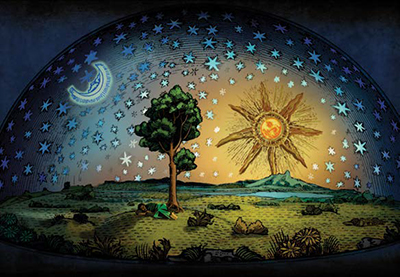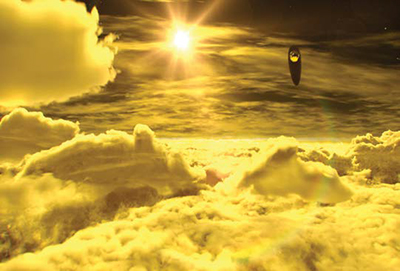The Return of ‘Cosmos’

ITHACA, N.Y.—On March 9, the Fox Networks Group, in conjunction with the National Geographic Channels International, launched us on a journey through time, space and history by airing a masterful new version of one of TV’s greatest scientific documentary series, “Cosmos.”
The original “Cosmos: A Personal Voyage,” produced by PBS affiliate KCET and first aired on PBS in 1980 was the brainchild of its host, Carl Sagan. It won three Emmy Awards, a Peabody, spawned one of the best-selling science books of all time, and was the most watched docu-series on the network until Ken Burns’ “The Civil War.”
CREATIVE AUTONOMY
Now, the same creative team behind the original series, writer/executive producer Ann Druyan (Sagan’s wife) and writer/ astronomer Steven Soter, this time under the helm of executive producer Seth Mac- Farlane (“Family Guy”), director Brannon Braga (“Star Trek” franchise) and executive producer Mitchell Cannold, president of Cosmos Studios in Ithaca, N.Y., where the series was produced, are bringing us “Cosmos: A Spacetime Odyssey” with host, astrophysicist Neil deGrasse Tyson.

Cosmos Host Neil de Grasse Tyson views the Milky Way galaxy from the “Spaceship of the Imagination.” “Ann Druyan, Steve Soter and I began to talk about a new ‘Cosmos’ series about seven years ago,” Cannold said. “We had offers from several networks but felt Fox would allow us the highest degree of creative control.”
It was after MacFarlane came on board with his previous successes at Fox that they received the creative autonomy they were looking for.
The results have made television history with the premier episode, prefaced with an introduction by President Obama saluting “the spirit of discovery,” and broadcast on 10 U.S. networks. These included Fox, National Geographic Channel, FX, FXX, FXM, Fox Sports 1, Fox Sports 2, Nat Geo Wild, Nat Geo Mundo and Fox Life, and earned it 8.5 million viewers in this country alone.
“Even after the first week I was already hearing from science teachers who are making the ‘Cosmos’ series a staple in their curriculum,” Cannold said. “I’ve been told Miley Cyrus tweeted about it to her 17 million followers.”
WORLDWIDE FOOTPRINT
But that is only the beginning. The premiere of “Cosmos: A Spacetime Odyssey” was also shown on 220 channels in 181 countries with a potential footprint of more than half a billion homes. It has even been translated into 45 different languages, in some markets dubbed, in others subtitled, and in several, dubbed and subtitled in two different languages at once.
The professional video industry's #1 source for news, trends and product and tech information. Sign up below.
After its cross-network premiere, “Cosmos: A Spacetime Odyssey” continues its epic 13-episode run, airing Sundays (9 - 10 p.m. ET/PT) on Fox, and Mondays (with bonus footage and behind-the-scenes content) on the National Geographic Channel (10-11 p.m. ET/PT).
“Seth, Ann, Neil and the entire team behind Cosmos have created one of the most incredible experiences ever imagined for television,” said Peter Rice, chairman and CEO, Fox Networks Group, “and we’re supporting it with the biggest launch we’ve ever orchestrated at Fox Networks Group.”
The theme of both the original “Cosmos: A Personal Journey” and “Cosmos: A Spacetime Odyssey” is how man’s comprehension of himself has been inspired by his quest for understanding the universe.
Carl Sagan began the original by saying, “The cosmos is all that is, or ever was, or ever will be.” In the new version, Sagan’s words are repeated as Neil deGrasse Tyson, standing on the same Big Sur shoreline where we first saw Sagan, invites us to adhere to a simple set of rules: “Test ideas by experiment and observation… follow the evidence wherever it leads, and question everything.”
Just as Sagan had done, in the first episode of the series Tyson welcomes us to join him in a “Spaceship of the Imagination” in which he takes viewers to the far corners of the universe before diving back through the spinning orbits of our own galaxy to arrive at the third planet of the sun.


As these images show, updating “Cosmos” allowed producers to dazzle viewers with graphics far more advanced than from the original 1980 version. Tyson also re-creates Sagan’s “Cosmic Calendar,” where the history of time from the Big Bang until now is condensed into a single year with all of human existence contained in a bright speck on the evening of Dec. 31st. However, this elaborate graphic gives evidence of the way our comprehension of the cosmos has evolved since the first “Cosmos” series, because Sagan’s Cosmic Calendar encompassed 15 billion years for the age of the universe, but Tyson’s reflects our revised estimate of 13.8 billion years.
VOYAGE OF EXPLORATION
The structure of both series is a voyage of exploration, but their methodology unveils man’s evolving concept of the reality around him by challenging established wisdom through the dichotomy of reason vs. belief, science vs. superstition.
To accomplish this, each journey intersperses revealing the wonders of the universe with historic examples of man’s ongoing attempt to climb out of the mud of chaos into the sunshine of awareness.
For example, in the first version, Sagan told us our search for intelligent life in the cosmos begins here on earth, “with the accumulated wisdom of the men and women of our species acquired at great cost over a million years.”
He then related the story of an Egyptian astronomer, Eratosthenes, who, by noticing how shadows lengthen as the day progresses, correctly deduced that the earth was round in 240 B.C. He even estimated its circumference within a few degrees of accuracy. Eratosthenes may have challenged the “flat earthers” of his time, but he became curator of the great Library of Alexandria, tutored Ptolemy, and lived to be 82.
However, in “Cosmos: A Spacetime Odyssey,” Tyson brings us back from his “Spaceship of the Imagination” tour of the universe with a lesson that sometimes knowledge is gained only at a price.
“There comes a time in our lives when we realize we are not the center of the universe,” he reminds us, “and as it happens to each of us, so it happened to our civilization in the 16th century.”
Tyson tells the story of a young Dominican monk, Giordano Bruno, who could not deny the truth of his vision of a universe as limitless as his concept of God. Bruno’s heroic quest to pierce the superstitious darkness of his time warranted the Inquisition to burn him at the stake on Feb. 17, 1600. Such is often the fate of those who dare to question sacred truths, but it is also often the cost of true progress.
It is significant that the introduction to each episode of this new series always begins with the letters “CS” appearing center screen which expand to the full title “Cosmos” between them.
Like dark matter leaving vestigial evidence of the Big Bang’s genesis, those two initials inevitably remind us of that great and wonderful teacher, Carl Sagan.
His call to commitment from the first “Cosmos” series echoes throughout its reincarnation:
We have lingered long enough on the shores of the cosmic ocean.
We are ready at last to set sail for the stars.
